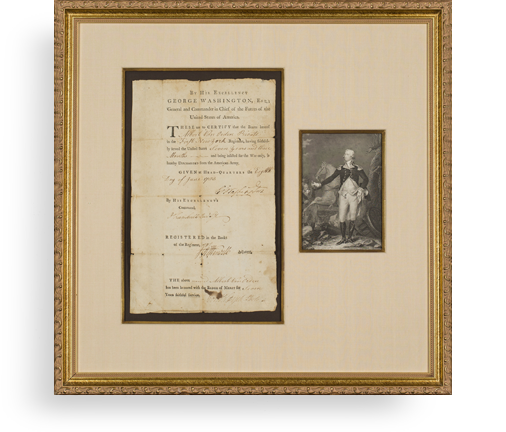Sold – A Contract to Build America’s First Road West – the Cumberland Road – Approved by President James Monroe




The Cumberland Road (also known as the National Road) was America's first federally funded interstate highway, and it was considered a wonder of the world when constructed. It was authorized on March 29, 1806, by President Thomas Jefferson, who believed that the awful roads of the day hindered American expansion, and that...
The Cumberland Road (also known as the National Road) was America's first federally funded interstate highway, and it was considered a wonder of the world when constructed. It was authorized on March 29, 1806, by President Thomas Jefferson, who believed that the awful roads of the day hindered American expansion, and that a trans-Appalachian road was necessary to encourage settlement of the west and unify portions of the young country. Construction began in Cumberland at the Potomac River at "a stone at the corner of lot No. 1, near the confluence of Will's creek and the north branch of the Potomac river" in May, 1811. It crossed the Allegheny Mountains and southwestern Pennsylvania, reaching Wheeling, Virginia (now West Virginia), on the Ohio River in 1818. At that point, though travel over the road across the Allegheny had begun, it now began in earnest. The Road's popularity in the 1820s was high, and it was celebrated in song, story, painting and poetry. During the 1840s attention was again focused on it, as travelers and drovers, westward bound, crowded the inns and taverns along the route. Huge Conestoga wagons hauled produce from frontier farms to the East Coast, returning with staples such as coffee and sugar for the western settlements. Untold thousands moved west in covered wagons and stagecoaches traveled the road keeping to regular schedules. Construction stopped at Vandalia, Illinois in 1839, after crossing the states of Ohio and Indiana.
David Shriver, an expert on turnpike management, was selected by Albert Gallatin, Secretary of the Treasury, as Superintendent of the Cumberland Road. He was responsible for all aspects of its construction, including the selection, hiring and supervision of contractors. He had the authority to sign contracts for materials and services, though for these the final approval of the President was required. He would also periodically report to Congress on both the progress and expenses of the road, and estimate the funds that would be necessary to build the next sections. Shriver soon earned a reputation as a no-nonsense perfectionist who would withhold payment to contractors if he was unhappy with their performance or materials. Part one of his project – Cumberland to Wheeling – ran for the then unheard of length of 123 miles, and there were enormous engineering hurdles, like the bridge over the Youghiogheny River. Its 80 foot span was the largest stone arch in America when constructed for the road.
In 1817 the end of the first portion of the project was in sight, with just the sections of the road west of the Youghiogheny River, and the bridge over the river itself, remaining to be completed. These sections were numbered starting at 23. The main ingredients used in the construction were stone, lime and timber, with the lime needed to make mortar to hold the masonry together. In early 1817 Shriver told Congress he would need about $1500 to buy the lime he would need for this portion. He found a contractor who could supply high quality lime at a fair price, and executed an agreement with him for it.
Document Signed, two pages large folio, February 25, 1817, being the original contract for lime for this purpose. It is “Between John Holdridge of the one part and David Shriver, Jr. duly authorized in behalf of the United States of the other part…The said John Holdridge agreed for and in consideration of the payments hereinafter mentioned to deliver on that part of the United States Western Road comprised in the 23rd, 24th, 25th and 26th sections, any quantity of merchantable lime necessary in the construction or building of, bridges, culverts or other works which may be thought necessary by the Superintendant.” The U.S. agreed to pay Holdridge forty cents per bushel of lime, so long as it was of sufficient quality. The document is signed by both Shriver and Holdridge. Signing as witnesses were Walter Slicer, a partner in the firm building the Youghiogheny Bridge (thus perhaps indicating that the lime was to be used for the bridge), and Samuel Magill, who established the first newspaper in Cumberland and was later its mayor. The contract was submitted to President Monroe, and is endorsed in the hand of the President, “Approved, James Monroe.”
This is the first contract for the landmark road to America’s westward settlement that we have seen, and a search of public records going back almost 40 years shows not one that has reached the marketplace. It is also interesting to note that Shriver's descendant, Sargent Shriver, also had a long career in public service and was the brother-in-law of President John F. Kennedy.

Frame, Display, Preserve
Each frame is custom constructed, using only proper museum archival materials. This includes:The finest frames, tailored to match the document you have chosen. These can period style, antiqued, gilded, wood, etc. Fabric mats, including silk and satin, as well as museum mat board with hand painted bevels. Attachment of the document to the matting to ensure its protection. This "hinging" is done according to archival standards. Protective "glass," or Tru Vue Optium Acrylic glazing, which is shatter resistant, 99% UV protective, and anti-reflective. You benefit from our decades of experience in designing and creating beautiful, compelling, and protective framed historical documents.
Learn more about our Framing Services












































































































